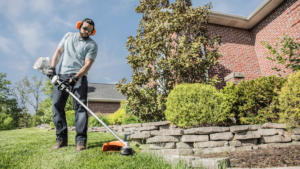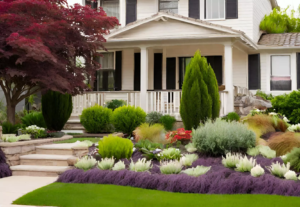Lawn Care Harrisburg PA includes weed control, fertilization, and pest control. It also includes mowing, watering, and aerating the lawn at appropriate times.
A healthy lawn starts with the soil. A soil test helps you understand what is in your dirt and where to start.

Water deeply in the early morning to prevent disease. This allows grass roots to soak up water and oxygen before the sun evaporates it.
Fertilize
Proper fertilization is the key to a healthy lawn. Grass requires nutrients like nitrogen, phosphorus, and potassium to thrive. The soil can usually supply these nutrients for most native plants, but turf grass needs extra help because of its rapid growth and frequent mowing. Feeding the lawn four times a year will keep it looking great while making it stronger and more resistant to heat, cold, drought, and disease.
Most fertilizers contain three primary nutrients – nitrogen, phosphorous, and potassium. Nitrogen promotes healthy leaf growth and helps the plant produce chlorophyll, which is necessary for photosynthesis. Nitrogen is quickly used up and depleted in the soil, and adding a lawn fertilizer with nitrogen is a good way to replenish it.
Phosphorus promotes root growth and helps the plant resist diseases. Potassium strengthens the grass so it can withstand stress from drought and other adverse weather conditions. The right ratio of N-P-K in the soil is important, and a soil test can determine what your yard needs.
There are many different kinds of lawn fertilizers available, natural and manufactured. All of them add nutrients to the soil and are safe for animals and people when used properly. Some organic fertilizers even improve the condition of the soil by increasing the amount of organic matter in it.
Some of the most popular lawn fertilizers also include herbicides, which prevent weeds from growing in the yard. These are called “weed-and-feed” products, and they can save you time in lawn care by doing two jobs at once. However, weed-and-feed products may be less effective than separate weed killers and fertilizers, and they can harm the environment when applied incorrectly.
Aerate
Keeping lawns healthy year-round requires ongoing maintenance services, such as mowing and aerating, soil testing, fertilizing, weed control and tree and shrub care. But providing these lawn services while managing labor, scheduling and pricing can be challenging for professional landscaping companies. The FieldRoutes Operations Suite delivers time-saving solutions that help lawn care and landscape contractors streamline, scale and grow their business.
Aerating is the process of mechanically piercing or removing small “plugs” from the lawn to break up soil compaction and allow oxygen, water and nutrients to penetrate deeper into the ground. Overtime, this helps promote root growth, reduce thatch buildup and stimulates grass. Aerating also helps eliminate the effects of excessive heat and drought stress by allowing the lawn to retain more moisture.
In the spring, lawns need to be raked and aerated to get back in shape after a long winter. Overseeding, core aeration and fertilizer application are also important for revitalizing the yard. Summer is a busy season for most lawns, but it’s still important to protect the grass from disease and insects, maintain proper mowing height, monitor for heat stress, and continue a regular watering schedule.
Mulching is another service that can improve the health of the lawn and add curb appeal to a property. A layer of mulch moderates soil temperature, helps preserve moisture and suppresses weed growth. It also adds nutrients to the soil as it breaks down.
Overseeding after aeration and adding compost to the soil is a great way to infuse new grass seeds with nutrients to promote vigorous growth. Overseeding is also an excellent opportunity to address brown spots or other problem areas by introducing new grass varieties that will thrive in those conditions.
Mow
Lawns that are not mowed regularly will become overgrown and require more time and effort to maintain their lush, healthy appearance. Overgrown lawns are harder to mow and can damage lawn mowers, causing costly repairs. Many lawn care companies offer scheduled mowing services to keep customers’ yards looking their best throughout the year.
Regular mowing also ensures that grass blades are at the optimal height for photosynthesis and nutrient absorption, so lawns remain strong against common diseases. It also prevents weed growth, as weed seeds cannot thrive in tall, dense grass. In addition, leaving grass clippings on the lawn decomposes and mixes with the soil to provide extra nutrients.
In addition to scheduled mowing, many lawn care and landscaping companies offer additional services such as bush and shrub trimming, flower planting, weed control, green waste disposal and edging. Some lawn care companies even offer pest control services to protect lawns against harmful insects.
Recurring revenue potential: Adding lawn cleanup services to your service portfolio is important, as this can be an annual or seasonal service that provides consistent and reliable income. Many homeowners and businesses need yard cleanup services in the fall when deciduous trees shed their leaves, as they can smother grass and harbor weeds and pests.
The most valuable part of offering lawn care and landscape maintenance services is establishing a strong and stable customer base. This can be done through a number of marketing and customer-oriented strategies, such as offering discounts or free services during the off season or by providing a convenient online scheduling and payment portal. For lawn care business owners looking to streamline their operations and grow their bottom line, the FieldRoutes Operations Suite delivers powerful software solutions that make it easier than ever for landscape contractors to simplify, automate and scale their businesses. Schedule a demo today to see how FieldRoutes can help your company!
Weed
Whether you’re a homeowner or part of a lawn maintenance crew, weeding is an essential component to maintaining a healthy yard. Weeds take up valuable space that could otherwise be used for turf grass and can choke out the health of your lawn, making it harder to enjoy and maintain.
If you’re looking to sell your home, having a well-maintained yard can increase the overall value of your property. However, if weeds are taking over, this can leave future buyers with doubts about the degree of care your lawn received and may even cause them to walk away completely.
Weeds also compete with grass for resources, stealing nutrients, water and sunlight that the turf needs to grow. If left unchecked, they can overtake the entire garden and choke out the lush, green grass that you worked so hard to cultivate.
Moreover, weeds are often the perfect hiding place for various pests that can be detrimental to your plants and grass. When weeds are cut back, these pests are exposed to the natural elements, leaving them with nowhere to hide and making it much easier to see if there is an infestation in progress.
The best way to prevent weeds is through routine weed control services. Pre-emergent herbicides can be applied in the spring to kill weed seeds as they emerge. It’s important to understand that these chemicals are not a quick fix and should be followed carefully to avoid killing the desired vegetation.
Regular weeding, coupled with a proper fertilization and mowing schedule, will help your lawn to build resistance to these pesky plants. Purchasing a bag of weed killer from your local home improvement store is an option, but hiring a professional lawn care company can save you both time and money in the long run.
Pest Control
Lawn pests can ruin grass by stealing nutrients from the plant or carrying disease to other plants and people. Controlling lawn pests is an important component of the overall maintenance program, ensuring healthy green spaces and providing safe environments for people and pets.
Lawn care providers often apply preventive sprays to control insects before they become problematic. Dormant oil can be used to control caterpillars, mites, and grubs. In addition, regular watering and frequent mowing will keep pest populations down by reducing food sources.
Insect pests such as cutworms, grubs, chinch bugs, and billbugs can devastate lawns by attacking the roots of the grass. Integrated Pest Management (IPM) techniques aim to eliminate pests while preserving the environment.
Identifying the types of pests in your yard is the first step to effective lawn care. A drench test is a simple way to check for soil insect pests. Simply add 2 to 4 tablespoons of liquid dish soap per gallon of water and apply it to an area about 1 square yard. Wait 10 minutes, then look for pests by checking the root zone and examining grass foliage and crowns. A quick count of pests will help you determine if a treatment is needed, which is generally only necessary when infestation levels reach a predetermined threshold.
A healthy lawn supports the ecosystem by providing a host of benefits to wildlife and human beings. It is also a more attractive place to spend time. A healthy lawn is less likely to attract disease-causing fleas and ticks, which can carry diseases such as typhus and Rocky Mountain spotted fever. In addition to pesticides, a good lawn care company will use biological and mechanical controls before turning to chemical treatments.
